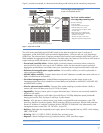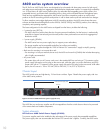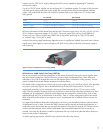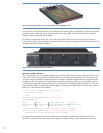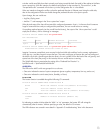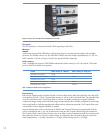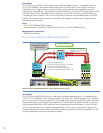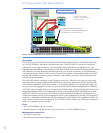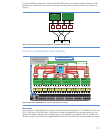
14
Figure 6: Closeup view of the HP ProCurve 6600 Switch Series LEDs
Processor
The CPU processor is a Freescale PowerPC 8540 operating at 667 MHz.
Memory
SDRAM
Synchronous Dynamic RAM (SDRAM) is used for the storage of uncompressed executable code and data
structures. The SDRAM consists of a 256 MB DDR-1 DIMM in the base module, expandable up to 1 GB. The
DDR-1 interface is 64 bits running at 166-MHz bus speed (333-MHz data rate).
Buffer memory
Table 1 highlights the amount of QDR SDRAM allocated for buffer memory for all 1-Gb and all 10-Gb data
ports for each of the 6600 series products.
Product Buffer memory for 1-Gb ports Buffer memory for 10-Gb ports
6600-24G switch (J9263A) 18 MB –
6600-24G-4XG switch (J9264A) 18 MB 18 MB
6600-48G switch (J9451A) 36 MB –
6600-48G-4XG switch (J9452A) 36 MB 36 MB
6600-24XG switch (J9265A) – 108 MB
Table 1: 6600 series buffer memory configurations
Flash memory
Both 24-port Gigabit products include 256 MB of Compact Flash and 4 MB of MirrorBit Flash. All other 6600
series products include 1 GB of Compact Flash memory as well as 4 MB of MirrorBit Flash. The MirrorBit Flash
is used for initial boot code. The Compact Flash is used for nonvolatile configuration storage (“NVRAM”).
Compressed image storage and the relatively large storage capacity allow multiple configurations and images
to be stored locally to facilitate upgrades and rollbacks during maintenance periods. The Compact Flash card
is removable for future upgrade capability if needed.
Because all application code is executed out of SDRAM, the Compact Flash may be programmed while the
switch is operational; that is, you can download new code onto the Compact Flash during system operation.
The Compact Flash is sized so that a backup copy of an older revision of application code also may be stored.
The system also allows you to hold up to three copies of configuration files, associating them to a particular
Flash image (primary => Config1, secondary => Config2, Active Running session => Config3).






